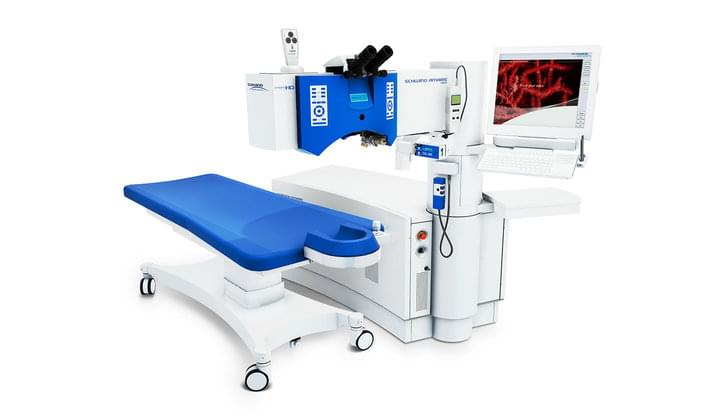transPRK – the new way of lasering
If you decide for laser treatment, you would like to obtain the best result possible. The more sophisticated the method, the better the performance. The SCHWIND AMARIS offers you the leading technology for your treatment providing excellence in all important aspects such as speed, precision, safety and comfort. Every laser treatment with the SCHWIND AMARIS begins with a comprehensive pre-examination. Based on the diagnostic information, your treating doctor exactly plans the treatment which optimally suits your eyes. He advises you with regard to an aberration-free treatment or wavefront-guided treatment (corneal wavefront and/or ocular wavefront). For this purpose, proprietary software calculates the profile which will be ablated by the laser. All ablation profiles are aspheric, which means that the natural curvature of your cornea and the biomechanics of your eye are considered.

FRПОЖАЛУЙСТА, НЕ СТЕСНЯЙТЕСЬ БРОНИРОВАТЬ НАЗНАЧЕНИЕ ПОД:
Тел.: +49 30 264797791
Aberration-Free Treatment
In an aberration-free treatment, simple refractive errors such as nearsightedness, farsightedness and astigmatism are corrected. With this method especially developed by SCHWIND, higher order aberrations that existed prior to the laser correction remain unchanged as long as they do not influence your vision. Thereby you retain your normal visual impression as with glasses or contact lenses. Your brain requires no learning phase for adapting to new, potentially disturbing changes. Furthermore, as opposed to other methods on the market, no aberrations emerge from the treatment that could reduce your visual acuity and your contrast vision.
Wavefront-Guided Treatment
If higher order aberrations influence your visual acuity, they should be corrected. In this case your doctor will recommend a treatment with the help of wavefront technology. These methods detect irregularities in the eye. Because no eye is perfect, the reflected light shows an individual pattern – the so-called wavefront. For an eye, this pattern is as characteristical as a fingerprint. By means of a resulting three-dimensional „map“, the laser can correct the finest asymmetrical distortions of the eye.
Your corneal wavefront shows whether significant high-order refractive errors exist
- in the cornea or
- within your entire eye.
Diagnosis is even more significant if the Corneal and Ocular Wavefront Analyzers are combined. Both measurements are then harmonized by the SCHWIND AMARIS software so that your doctor can determine whether higher-order refractive errors on your corneal surface and other defects of your optical system compensate each other or aggravate each other.
For quickly seeing more clearly: Speed and precision through SCHWIND AMARIS
Speed is only beneficial if it comes along with precision. The SCHWIND AMARIS possesses unique characteristics providing a perfect balance between ablation speed and precision during the treatment. You will find more information on the individual features such as „1050 Laser Pulses per Second“ and „Automatic Fluence Level Adjustment“ in the right column. The principle of Automatic Fluence Level Adjustment will be explained in the SCHWIND AMARIS video file.
1050 laser pulses per second
The shorter the surgery, the smaller the risk – the SCHWIND AMARIS works two to three times faster than other systems for refractive surgery. 1050 tiny light flashes per second shape the corneal surface with the SCHWIND AMARIS. As a result, the SCHWIND AMARIS is extremely fast and ablates a dioptre of myopia in 2.0 seconds. The advantage for you is that you only need to focus on the fixation light for a shorter time. Furthermore, the corneal tissue is only exposed for a very short time. This prevents drying out and accelerates the regeneration process.
Automatic Fluence Level Adjustment
Because high speed alone does not yield exact results, SCHWIND developed the worldwide unique method of automatic fluence level adjustment. This makes for a perfect combination of speed and precision with the SCHWIND AMARIS. The method is illustrated by the following picture: A fast yacht heads for a harbour at a high speed, a small sport boat navigates then exactly to a narrow landing. At first, the SCHWIND AMARIS laser uses a high energy level for ablating approx. 80 percent of the corneal tissue. How long the powerful beams are applied depends on the strength of your refractive error and is continuously reviewed by the software during the surgery. A gentler beam then ablates the remaining 20 percent, thus assuring an especially smooth surface and perfect vision.
Exceptionally fine laser beam
The laser beams of the SCHWIND AMARIS have an exceptionally small diameter. They have a size of only 0.54 millimetres and are thus significantly smaller than others. Furthermore they have a special shape referred to by scientists as a Super-Gaussian beam profile. Your cornea becomes especially smooth with this fine beam.
Highest precision through a stable microclimate
With the SCHWIND AMARIS, two specially-formed nozzles ensure a directed, fine airflow that creates a stable microclimate across the cornea. Particles that could shield energy during treatment are thereby effectively removed. At the same time, climatic conditions remain constant, preventing the cornea from drying out.
If you want to avoid risks: Safety through the SCHWIND AMARIS
If you decide for laser treatment, you would like to be on the safe side. The SCHWIND AMARIS possesses unique characteristics providing the highest safety standard possible during laser treatment. You will find more information on the individual features „eyetracking system“, „five-dimensional eye tracking“, „online pachymetry“ or „“thermal control“ in the right column.
- Turbo fast eye tracking system: The SCHWIND AMARIS is very fast and nonetheless safe, also due to its eye tracking system. The eye tracker registers 1050 times per second how your eye moves during the surgical procedure. The laser beam can thus always be perfectly positioned.
- Blickverfolgung in fünf Dimensionen: In addition to horizontal and vertical eye movements, the eye can also rotate, roll and tilt. The SCHWIND AMARIS registers all of these movements with an eye-tracking-system that compensates every movement of the eye up to the fifth dimension. Imagine your eyeball being a buoy in the sea: When the sea is calm, the buoy shifts from the left to the right or forward and backward. In swell, however, the buoy tilts to the side. Furthermore, a buoy also turns around its anchorage. In the same manner, your eyeball can roll (rotation) or rotate around its own axis (cyclotorsion).
The SCHWIND AMARIS checks every eye movement and compensates them. With cyclotorsion control the compensation occurs statically, between sitting and lying positions of the patient, and dynamically during the laser treatment. In the context of static cyclotorsion control, the SCHWIND checks the pupil size before the laser procedure and employs so much light until the pupil diameter is exactly as it was during the pre-examination. The treatment zone remains where it was previously established. If the doctor, for example, turns off the illumination during the surgery in order to make the patient feel more comfortable, another safety mechanism takes over: Simultaneously with pupil recognition, the eye tracker also detects the limbus, whose size always remains the same as opposed to the pupil diameter. In this way, the same ablation centre is retained, even under changing light conditions. This prevents decentrations that could lead to irregularities on the cornea.
- Corneal thickness measurement as safety system : Online pachymetry serves the continuous measurement of the cornea’s thickness during the entire surgical procedure. This assures that the cornea is still stable (thick) enough, also after the laser correction. Similar to a diver orientating himself in water with his depth gauge, the doctor is permanently informed through online pachymetry during the entire procedure with the SCHWIND AMARIS. This system measures changes in corneal thickness and displays them on the monitor in online-time. At every point in time your doctor knows exactly how much he already has ablated and how thick the remaining cornea still is. The measurement device itself delivers the data contact-free: direct contact with the eye is avoided.
- Unique thermal control (Intelligent Thermal Effect Control): The cornea can dry out during the surgical procedure if it becomes too warm. The result would be a milky layer instead of a clear vision. The SCHWIND AMARIS is equipped with a unique thermal control system. Even at higher ablation speeds the corneal tissue is effectively preserved. The laser pulses are temporally and spatially sorted, which gives the individual position on the cornea sufficient time to cool off. As other lasers do not offer this technology, they are only able to employ fewer laser pulses per second and are therefore decisively slower.
So that your doctor can totally concentrate on your eyes
The SCHWIND AMARIS offers the surgeon much assistance. Due to the high user comfort he can devote his full attention to your eyes during the entire surgery – supported by technology. The small display shows the most important status information in the surgeon’s line of vision. The surgeon has the laser indications and the program sequence as exactly in sight as your eyes. With a single push of a button he can call up his preferred working conditions and presettings. Touch screen monitors offer even more comfort.
You also benefit from other advantages of the SCHWIND AMARIS: For example, a diagnostic slit lamp is located directly on the device. In this way, your doctor can immediately evaluate the ablation after the surgery without changing the examination room. And thanks to its swivelling bed, the SCHWIND AMARIS can be combined with a femtosecond laser, without having to get up.
Visual acuity
The vast majority of patients could see absolutely clear: 98 percent of treated eyes achieved 100 percent vision or better. Among those, 65 percent arrived at a visual acuity of at least 125 percent. A top group of seven percent even obtained a visual acuity of more than 160 percent. The study also compares the results with the situation before the treatment when using optical aids: According to this, 55.5 percent could see even better after the surgical procedure than before with glasses or contact lenses. 44 percent could see exactly as well as before.
Healing process
The eyes of the patients regenerated very quickly after a SCHWIND AMARIS LASIK treatment. On average a visual acuity of 108 percent was achieved already one day after the surgery. Normally one expects such values after one week. Six months after treatment visual acuity amounted to an average of 117 percent. After this period values are regarded as being stable.
Contrast and night vision
Only some years ago reduced contrast sensitivity was the rule. Even nowadays a loss of contrast sensitivity may occur after standard laser treatment. On the contrary, the study showed that the SCHWIND AMARIS spectacularly improves contrast sensitivity.
Dates by arrangement
Location Berlin
Paulig Eye & Health
Operation / Laser / Anti-Aging
Unter den Linden 16
10117 Berlin
Location Kurort Oberwiesenthal
Paulig Eye & Health
Karlsbader Straße 6
09484 Oberwiesenthal
Location Saudi Arabia
Al Faisaliah Tower
Level 18
King Fahad Highway, Olaya District | Riyadh
Kingdom of Saudi Arabia



